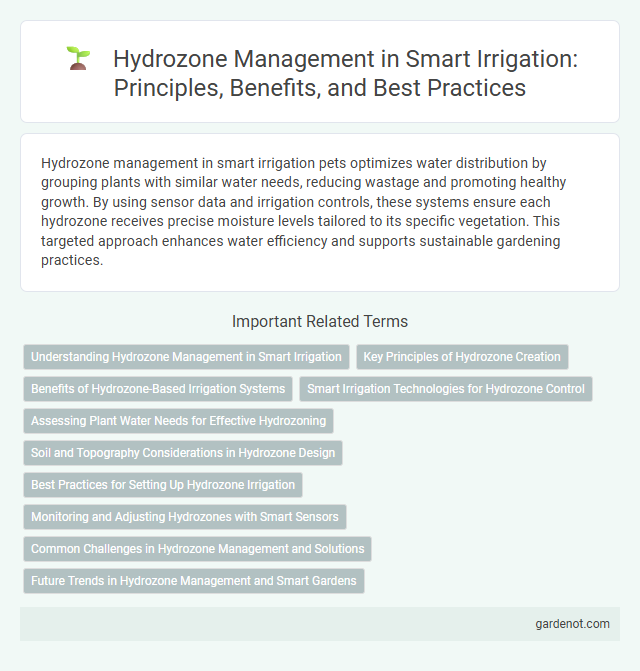Hydrozone management in smart irrigation pets optimizes water distribution by grouping plants with similar water needs, reducing wastage and promoting healthy growth. By using sensor data and irrigation controls, these systems ensure each hydrozone receives precise moisture levels tailored to its specific vegetation. This targeted approach enhances water efficiency and supports sustainable gardening practices.
Understanding Hydrozone Management in Smart Irrigation
Hydrozone management in smart irrigation involves grouping plants with similar water requirements to optimize irrigation schedules and conserve water. By tailoring watering based on plant type, soil conditions, and sun exposure, smart controllers enhance efficiency and reduce wastage. This practice supports sustainable landscaping by promoting precise water delivery and maintaining plant health.
Key Principles of Hydrozone Creation
Hydrozone management optimizes water efficiency by grouping plants with similar water requirements and soil types to create distinct irrigation zones. Key principles of hydrozone creation include analyzing plant water needs, soil moisture retention capacity, sun exposure, and slope to tailor irrigation schedules precisely. Properly designed hydrozones reduce water waste, prevent overwatering, and promote healthy plant growth by delivering targeted irrigation based on specific landscape characteristics.
Benefits of Hydrozone-Based Irrigation Systems
Hydrozone-based irrigation systems enhance water efficiency by grouping plants with similar water requirements, reducing overwatering and runoff. These systems optimize plant health and growth by delivering precise moisture levels tailored to each zone's needs. Implementing hydrozone management also lowers operational costs and conserves resources, promoting sustainable landscape irrigation practices.
Smart Irrigation Technologies for Hydrozone Control
Smart irrigation technologies for hydrozone control optimize water distribution based on plant water needs, soil type, and microclimate conditions, enhancing efficiency and reducing waste. Advanced sensors and IoT (Internet of Things) devices enable real-time monitoring and automated adjustments, ensuring precise irrigation schedules for each hydrozone. Integration with weather data and predictive analytics further refines water application, promoting sustainable landscape management and conserving water resources.
Assessing Plant Water Needs for Effective Hydrozoning
Assessing plant water needs involves analyzing species-specific water requirements, soil type, and microclimate conditions to create efficient hydrozones that reduce water waste. Grouping plants with similar evapotranspiration rates into distinct irrigation zones allows precise scheduling, minimizing overwatering and promoting healthy growth. Integrating soil moisture sensors and weather data enhances real-time adjustments, optimizing water use and sustaining landscape health.
Soil and Topography Considerations in Hydrozone Design
Soil type significantly impacts water retention and drainage, making it essential to group irrigation zones based on soil texture and permeability to optimize water use in hydrozone design. Topography influences runoff and water distribution, requiring adjustments in irrigation scheduling and emitter placement on slopes to prevent erosion and ensure uniform coverage. Effective hydrozone management integrates these soil and topographic factors to enhance irrigation efficiency and plant health.
Best Practices for Setting Up Hydrozone Irrigation
Effective hydrozone management involves grouping plants with similar water requirements to optimize irrigation efficiency and conserve water. Best practices for setting up hydrozone irrigation include analyzing soil types, plant species, and microclimate conditions to tailor watering schedules accurately. Utilizing smart controllers and moisture sensors ensures precise irrigation that reduces runoff and promotes healthy plant growth.
Monitoring and Adjusting Hydrozones with Smart Sensors
Smart sensors enable precise monitoring and adjusting of hydrozones by continuously tracking soil moisture, temperature, and weather conditions to optimize water use. These sensors collect real-time data, allowing irrigation systems to automatically modify watering schedules and amounts, reducing water waste and promoting healthier plant growth. Efficient hydrozone management through smart sensor technology improves landscape performance while conserving water resources.
Common Challenges in Hydrozone Management and Solutions
Common challenges in hydrozone management include uneven water distribution, soil variability, and plant species with differing water requirements, leading to inefficient irrigation and water wastage. Implementing smart irrigation systems with soil moisture sensors and weather data integration optimizes water application based on real-time conditions and plant needs. Precision mapping and automated zone control improve resource efficiency and promote sustainable water use in hydrozone management.
Future Trends in Hydrozone Management and Smart Gardens
Future trends in hydrozone management emphasize advanced sensor integration and AI-driven water scheduling to optimize irrigation efficiency in smart gardens. Precision data on soil moisture, plant type, and microclimate conditions enable dynamic adjustments that reduce water waste and promote plant health. Emerging technologies like IoT connectivity and machine learning algorithms foster adaptive hydrozones tailored to environmental changes and seasonal variations.
Hydrozone management Infographic

 gardenot.com
gardenot.com